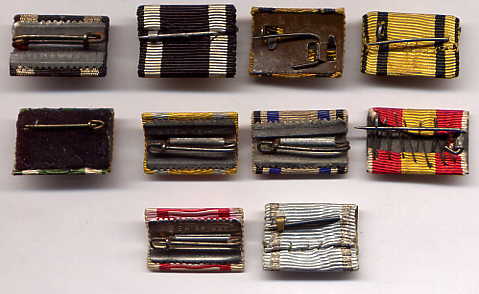
Content - Richard Lundström
Layout - Sebastian Bianchi
M1915 New Style (World War One period)
The regulations of 1915/16 never actually mentioned the WIDTH the new reduced size ribbon bars were to be, only their HEIGHT- 17 mm. The 15 mm width already used for lapel bows and naval trapezoids was an obvious choice, and became the standard size until 1945, though 25 mm was also popular- and the only width used for single ribbon bars. In many cases, soldiers simply snipped off lengths of the ribbon that had come with their presentation awards and improvised field ribbon bars. Sewn on ribbon bars also existed from the beginning, though a distant third in popularity, for obvious reasons.
An enormous original ribbon bar like this was far from common- most officers would never have racked up the sort of multi-state decorations shown here unless they were senior Guards or Staff types. This officer was neither. Surprisingly, he was a mere humble infantry Hauptmann der Landwehr. Dr. Carl Beutin's unique array of pre-war Orders are "inexplicable" simply reading the 1914 Rangliste-only a Court And State Handbook tells the rest of his story-he was the Secretary of the Mecklenburg-Schwerin Orders Chancery, and accumulated these for processing other awardees' paperwork!

Of course, being able to put a name and career on most anonymous ribbon bars is clearly impossible. For a successful match either a unique pre-war combination of awards or a similar post-war military career were required, since only in those cases will period sources reveal an officer's identity from his decorations. Unfortunately, none of these impressive bars belonged to officers in either category-untraceable pre-war, highly decorated during the war, yet not remaining in service.
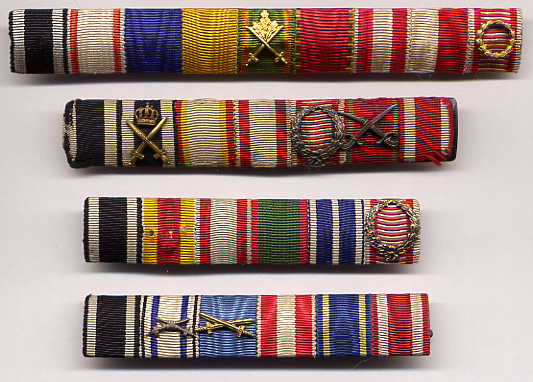
Bottom Bar - TP
Nor were long ribbon bars like those at all the norm during the First World War. For many officers and most enlisted men, a single ribbon or a pair for natives of all the states that also bestowed wartime awards were all that most could hope for.
Single obverses;
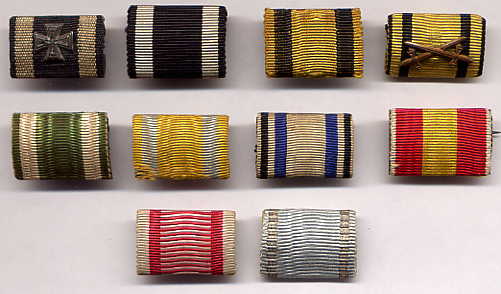
Single reverses;
|
|
| Note the patent "sawtooth" gripping edges, metal parts painted Feldgrau during the war, but commonly nickled thereafter. TP+ |
Here are some representative M1915 ribbon bars. Most were worn by officers, as the Orders show. Even on a bar where all the awards could have been won by all ranks, chances of an enlisted man actually getting more than two were remote.
Obverses;

Reverses;
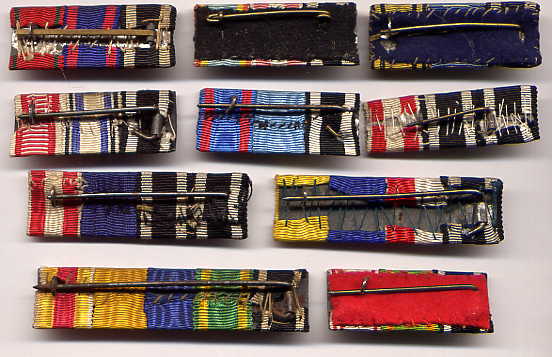
Types of tinned steel ribbon bars were being improvised by individual military effects retailers throughout the First World War, producing some odd "first generation" variants. This bar to a former colonial and Schutztruppen officer, holder of the Prussian Life Saving Medal, has a very low catch which necessitated a "Model T crank" bend in the pin, which has flattened here over the decades since.
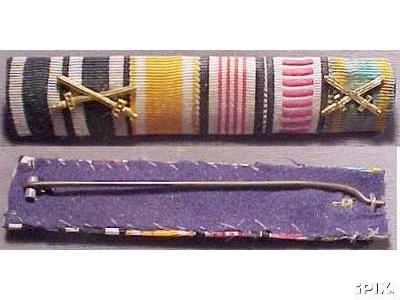
Sewn-on varieties also existed, but were obviously less practical for frontline wear and tear. This example belonged to a Bavarian nobleman serving in a cavalry regiment. Note the wear where the ribbons flexed. The interior backing is a semi stiff thin fiber/cardboard.
|
|
| The Austro-Hungarian Marianerkreuz, the last ribbon, was only given to members of the nobility for volunteer service in the Teutonic Order's hospitals. It was NOT a medical corps related award. |
This bar is on Duke Robert of Württemberg's M1915 cavalry Generalmajor Bluse. Although the ribbons appear to be for normal medal bar grades of wartime Orders, most of these were awarded to the Duke in Commander grades, so that he was wearing them in imitation of the Austrian "Kleindekoration" system. As a younger brother of the man who would have become the next King of Württemberg, Duke Robert wore a number of dynastic jubilee etc awards here-before his non-Württemberg WAR decorations!-that were usually omitted for "duration" wear.
 |
| Note either an incorrect should have been gold device on the Turkish Imtiaz Medal 3rd from the end, or an incorrect double Imtiaz ribbon when a Liakat was meant in next to last place. Even a Duke could have mistakes in his awards! CW |
Lesser mortals-even commissioned ones-often made due with bars improvised from their full size ribbons. Here are two versions compared with a normal 15 mm width type.
Obverses;
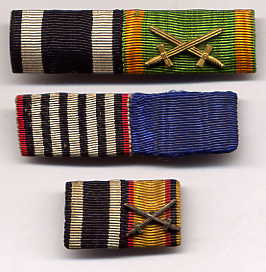
TP
Reverses;
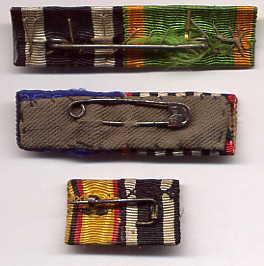
TP
Rare indeed was a noncommissioned officer who could boast of a bar like this;

RV
This Saxon NCO had a Saint Henry Order Medal, the Saxon Honor Cross with Swords ( a peculiar "make due" award usually only given to senior sergeants for whom no other "appropriate" award could be made), Saxon Friedrich August Medal on the war ribbon, Prussian Iron Cross (here with pointlessly fashionable "dude" mini in common use, especially in Saxony, from 1919 on), and a Saxon Long Service award. Though the mini dates this as ca 1919, it may be possible that Saxons were wearing this device earlier, actually during the war.
One last type of ribbon bar remains-the "anti-ostentatious" 12.5 mm form. This example is a double ribbon woven as one piece for the Prussian Iron Cross 2nd Class and Brunswick Ernst August Cross 2nd Class, as compared with the usual 15 mm size with individual ribbons.
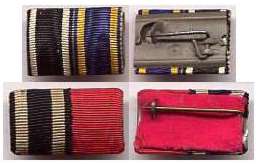
TP
This variety was normally only used much later to "squeeze" many awards (see In Wear Photo Gallery) onto a single row of ribbons. It was scarce in any period. This is an enlargement of the reverse, showing the Feldgrau detachable tab bar construction, with "DRP" markings in the center running sideways bottom to top.
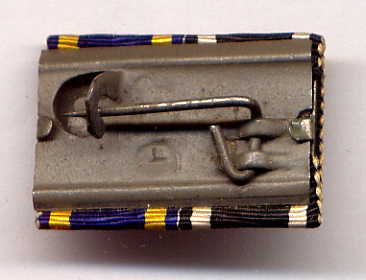
TP
![]()
© Copyright Wehrmacht-Awards.com LLC |
